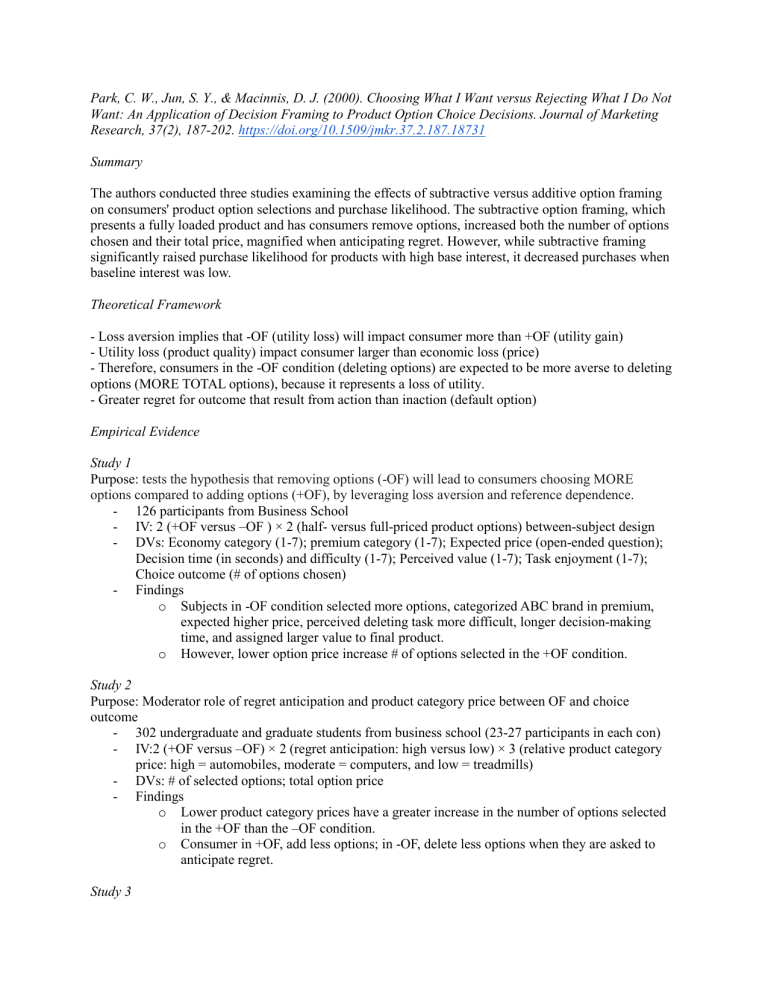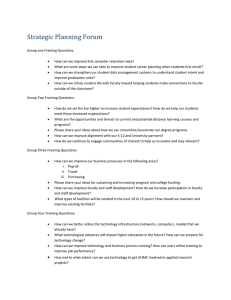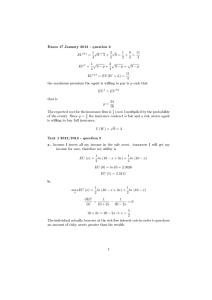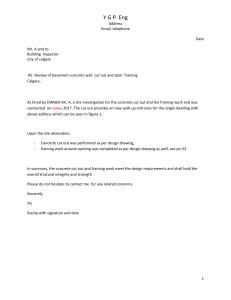
Park, C. W., Jun, S. Y., & Macinnis, D. J. (2000). Choosing What I Want versus Rejecting What I Do Not Want: An Application of Decision Framing to Product Option Choice Decisions. Journal of Marketing Research, 37(2), 187-202. https://doi.org/10.1509/jmkr.37.2.187.18731 Summary The authors conducted three studies examining the effects of subtractive versus additive option framing on consumers' product option selections and purchase likelihood. The subtractive option framing, which presents a fully loaded product and has consumers remove options, increased both the number of options chosen and their total price, magnified when anticipating regret. However, while subtractive framing significantly raised purchase likelihood for products with high base interest, it decreased purchases when baseline interest was low. Theoretical Framework - Loss aversion implies that -OF (utility loss) will impact consumer more than +OF (utility gain) - Utility loss (product quality) impact consumer larger than economic loss (price) - Therefore, consumers in the -OF condition (deleting options) are expected to be more averse to deleting options (MORE TOTAL options), because it represents a loss of utility. - Greater regret for outcome that result from action than inaction (default option) Empirical Evidence Study 1 Purpose: tests the hypothesis that removing options (-OF) will lead to consumers choosing MORE options compared to adding options (+OF), by leveraging loss aversion and reference dependence. - 126 participants from Business School - IV: 2 (+OF versus –OF ) × 2 (half- versus full-priced product options) between-subject design - DVs: Economy category (1-7); premium category (1-7); Expected price (open-ended question); Decision time (in seconds) and difficulty (1-7); Perceived value (1-7); Task enjoyment (1-7); Choice outcome (# of options chosen) - Findings o Subjects in -OF condition selected more options, categorized ABC brand in premium, expected higher price, perceived deleting task more difficult, longer decision-making time, and assigned larger value to final product. o However, lower option price increase # of options selected in the +OF condition. Study 2 Purpose: Moderator role of regret anticipation and product category price between OF and choice outcome - 302 undergraduate and graduate students from business school (23-27 participants in each con) - IV:2 (+OF versus –OF) × 2 (regret anticipation: high versus low) × 3 (relative product category price: high = automobiles, moderate = computers, and low = treadmills) - DVs: # of selected options; total option price - Findings o Lower product category prices have a greater increase in the number of options selected in the +OF than the –OF condition. o Consumer in +OF, add less options; in -OF, delete less options when they are asked to anticipate regret. Study 3 Purpose: The moderator role of product category commitment between OF and category purchase - 101 graduate business school students (24-27 participants in each condition - IV: 2 (+OF versus –OF) × 2 (low versus high commitment) between-subjects design. - DV: Purchase decision (Y or N, why?); likelihood to purchase (1-7); # of important and unimportant options chosen; all DV od study 1. - Findings o Low commitment economic loss more salient less category purchase in -OF (reference price is higher, more expensive) o High commitment OF has no effect on category purchase o OF no effect on important options chosen, but subjects choose more unimportant options in -OF than +OF. Takeaway Adding (+OF) or removing (-OF) options framing leads to consumer’s asymmetric decision making. Likes - Clearly demonstrate power of framing effects with bunch of DVs Actionable implications for managers in product positioning Explains why framing alters decisions via loss aversion, utility loss > monetary loss. Resume example in the article helps provide an intuitive understanding subtle framing differences can lead to asymmetric decision making. Dislikes - Nice finding, but as one of the consumers, I may worries about managers or marketers take advantage of this and make me spend more money on options that is not necessary Discussion - - - Does not measure long-term brand perception shifts! Removing options (-OF) may increase spending and value perceptions at first. But over the longer-term, consumers may update anchor prices and reference prices negatively if they regret expensive purchases. This could ultimately hurt brand positioning and repurchase intent? May depend on option types - less generalizable! The studies focused on consumer electronics and automotive options. These are complex configurable products - may not hold for simpler singular product purchases such as air cleaners? In the article car as a product which can be either hedonic and utility, any difference in hedonic or utility products different? Ethical problem needs to be clarified!






